Table of Contents
Definition of Cell Wall
A cell wall is considered as a non-living component of a cell which covers the outermost layer of a cell. Based on the species the cell wall composition is varied. It acts as a barrier between the interior part of the cell and the exterior part of the cell.
Cell wall is one of the most essential parts of the bacterial cell, external to the cytoplasmic membrane. A cell wall is tough, flexible, and sometimes rigid.
Most bacteria have a protective layer called the cell wall that surrounds and protects the cell membrane. It helps the cell stay together, keeps its form, and prevents osmotic lysis (bursting due to differences in water concentration between the cell and its environment). Peptidoglycan, a polymer comprising N-acetylglucosamine (NAG) and N-acetylmuramic acid (NAM) sugars and short peptide chains, is what makes up the bacterial cell wall. The robustness of the cell wall is due to the way in which these peptide chains intertwine and cross-link with one another, creating a mesh-like structure.
Many bacterial species can have cell walls that are vastly varied in composition and thickness. Unlike gram-negative bacteria, which have a single layer of peptidoglycan in their cell wall surrounded by an outer membrane, gram-positive bacteria have a thick cell wall composed of numerous peptidoglycan layers. Lipopolysaccharides are found in the outer membrane of gram-negative bacteria and are both vital to the immune response and poisonous to some mammals.
Many antibiotics, including those that kill bacteria, work by blocking the production or activity of peptidoglycan, a component of the cell wall. This results in a weakened cell wall that is more easily lysed, which kills the bacterium. The development of new antibiotics and an appreciation of bacterial interactions with their surroundings necessitate an appreciation of the structure and function of the bacterial cell wall.
Bacterial Cell Wall Types
Based on the result of gram staining it is stated that there are two types of cell wall such as
- Gram-positive cell wall (+Ve)
- Gram-negative cell wall (-Ve)
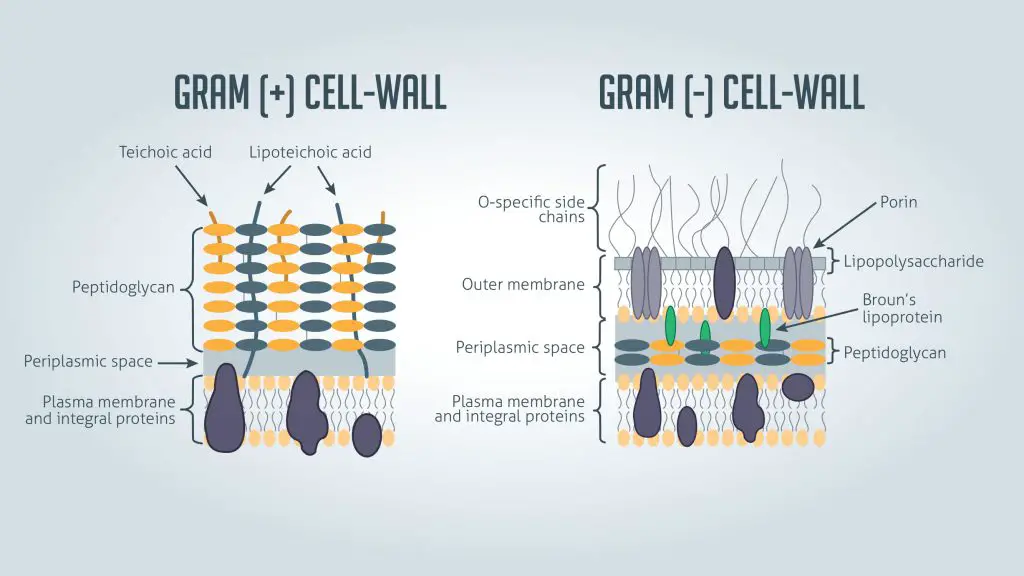
Cell wall structure of gram-positive bacteria
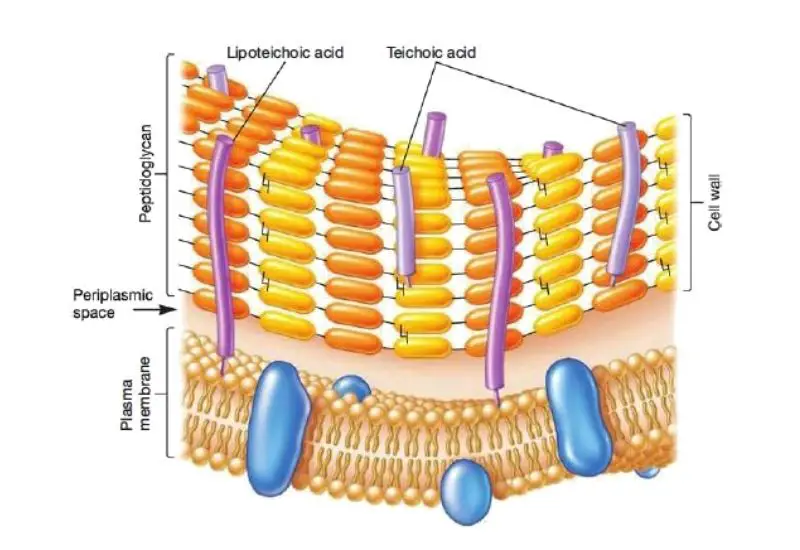
- Most of the gram-positive bacteria contain a single 20-80 nm thick peptidoglycan layer. It is accounts for 40-90% of dry weight.
- The thickness of the peptidoglycan may vary from species to species and it provides rigidity to the cell wall.
- Besides peptidoglycan, there have another acidic polymer, containing phosphorus known as Teichoic acid.
- The cell wall of gram-positive bacteria is known as murein.
- During the gram staining, the gram-positive bacteria take up the crystal violet dye and become purple.
- This type of cell wall can be completely dissolved with the attack of enzyme lysozymes. This enzyme breaks the bond between N-acetylmuramic acid and N-acetylglucosamine.
- The cell wall of Staphylococcus aureus is exceptional, it can resist the action of lysozymes. Because the carbon-6 of some muramic acid residues contain O-acetyl groups.
- The cell wall of gram-positive bacteria contain two types of teichoic acid such as ribitol teichoic acids and glycerol teichoic acids. These are the polymer of polymers of ribitol phosphate and glycerol phosphate and only found on the surface of gram-positive bacteria.
Cell wall structure of gram-negative bacteria
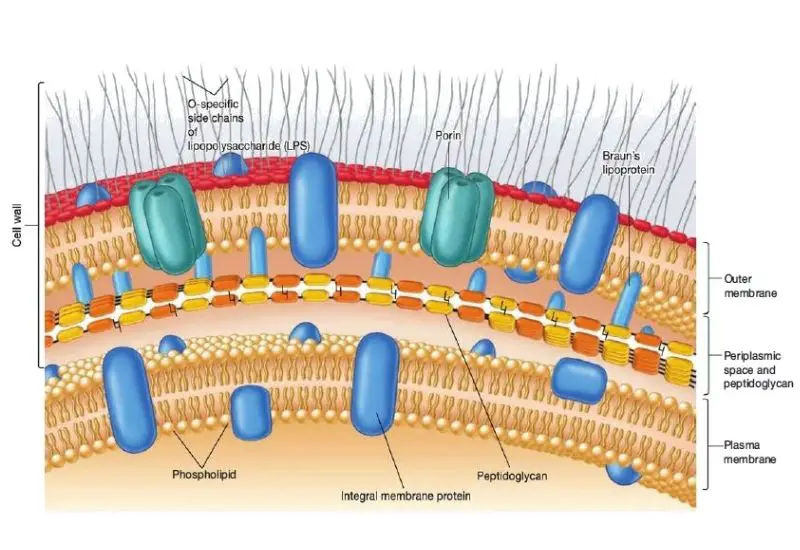
- The cell wall of gram-negative bacteria is much thinner as compared to gram-positive bacteria.
- They also have a 2nd plasma membrane superficial to their light peptidoglycan layer, in turn, next to the cytoplasmic membrane.
- During gram staining, the cell wall of these bacteria are stained as pink color.
- Gram-negative bacteria contain peptidoglycan but in a very low amount. It occupies 5-10% of the cell wall in gram-negative bacteria.
- They lack teichoic acid in their cell wall.
- The peptidoglycan layer is surrounding by an outer membrane. So, a space is seen between the plasma membrane and the outer membrane. This space is called periplasmic space.
- This space may be filled with a loose network of lipoproteins and a huge amount of enzymes and transport proteins.
- The outer layer is bilayer and consists of protein and lipopolysaccharide.
- The outer membrane’s lipopolysaccharides are responsible for many of the antigenic properties.
Bacterial Cell Wall Structure
The bacterial cell wall is made up of different components which are divided into the following groups
Internal Component of Bacterial Cell Wall
Peptidoglycan
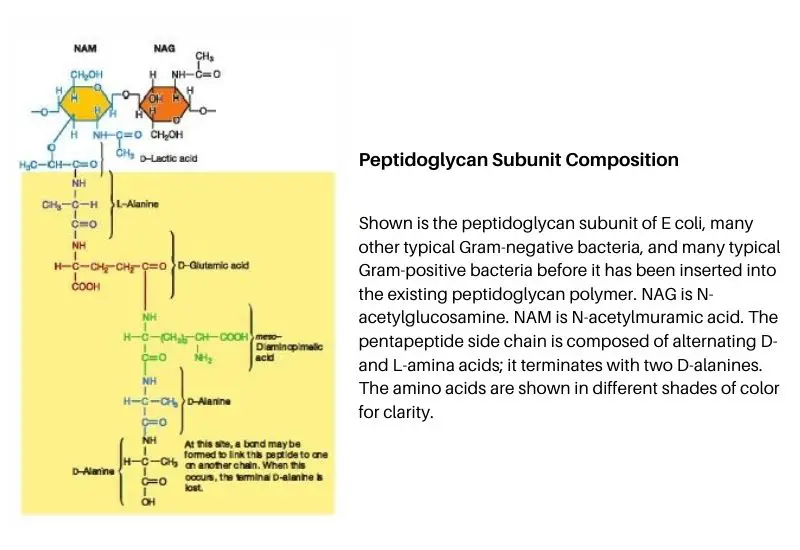
- The general composition of peptidoglycan differ from species to species, but there are basic similarities.
- Peptidoglycan is a very large polymers composed of three kinds of building blocks such as;
- Glycan backbone: 2 sugar derivatives linked by Beta-1,4-glycosidic linkage, called N-acetylglucosamine and N-acetyl muramic acid.
- Tetra-peptide: A tetrapeptide side chain of L-alanine, D-glutamine acid, L-lycine (gram-positive), or Mesodiaminopimelic acid (gram-negative).
- Peptide cross-linkage: A pentapeptide cross-bridge of glycine (gram-positive) or direct peptide cross bridge.
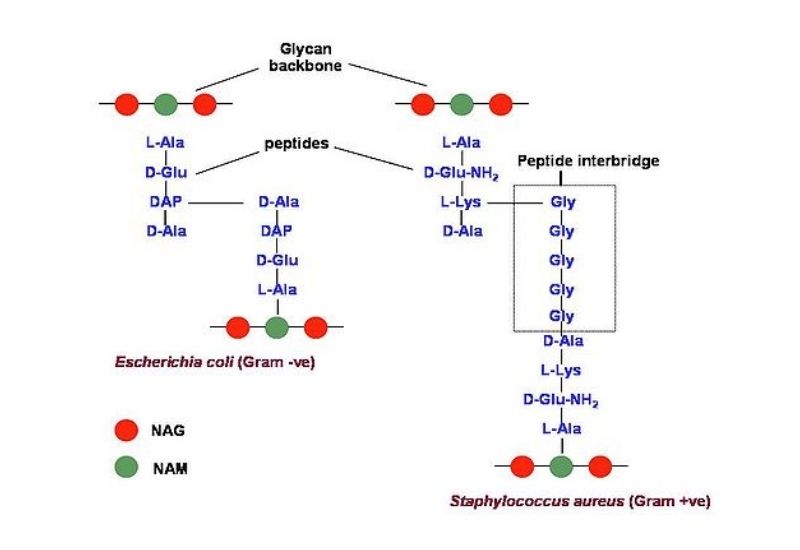
- The sugar derivatives are linked by Beta-1,4 linkage and then four amino acids linked two NAM serially (L-Alanin, D-Glutamic acid, L-Lycine/Mesodiaminopemilic acid, D-alanine).
- The third amino acid varies with different bacteria (In gram-positive bacteria L-lysine and In Gram-negative bacteria mesodiaminopemilic acid).
- In gram-positive bacteria, the parallel tetrapeptide side chains are linked by a pentapeptide (glycine) cross bridge that links the third amino acid of one tetrapeptide fourth amino acid of another tetrapeptide.
- In gram-negative bacteria, the amino acid group of the third amino acid is linked with the carboxyl group of the fourth amino acid of another tetrapeptide side chain by signal peptide bond.
- The rigidity of the cell wall depends on a number of cross-linked molecules.
The members of the phylum Chlamydiae and Planctomycetes both lack peptidoglycan in their cell walls. These are gram-negative strains.
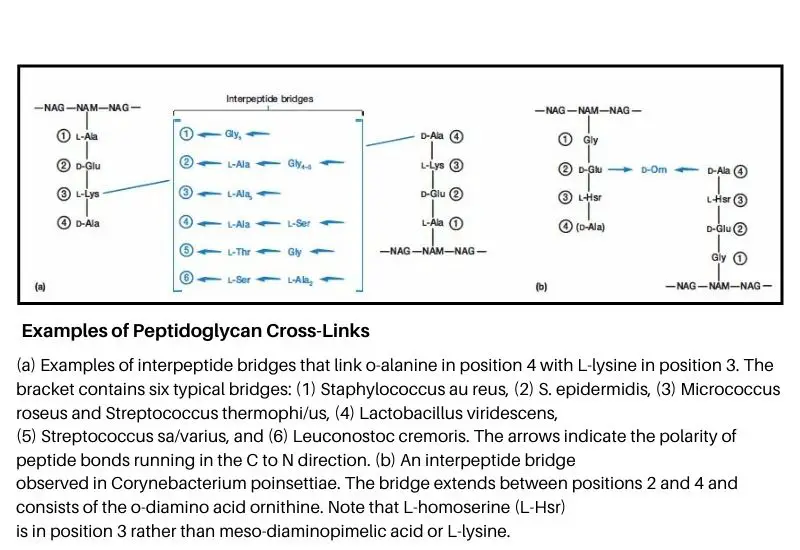
Teichoic acid
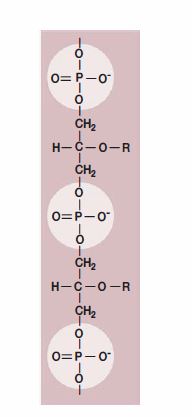
- Many gram-positive bacteria contain acidic polymers of sugar, teichoic acid embedded in their cell wall.
- Teichoic acid consists of alcohol (Ribital or glycerol) and phosphate.
- These poly alcohol are connected to phosphate by ester link and other sugar, alanine is attached to the carboxyl group.
- They are responsible for the negative charge of the cell wall and help the movement of ions through the cell wall, it also prevents the lysis of the cell wall.
- Teichoic acid composes about 50% of the dry weight of the cell wall.
- In gram-positive bacteria, Teichoic acid is the major surface antigen.
Types of Teichoic acid
There are three types of Teichoic acid such as;
- Ribitol teichoic acid (Staphylococcus aureus)
- Glycerol Teichoic acid (Bacillus subtilis)
- Glycerol Ribital teichoic acid (Bacillus licheniformis)
Lipo-protein
- Lipo-protein complex is found on the inner side of the outer membrane.
- Lipo-protein has a molecular weight of about 700 daltons and consists of 58 amino acids.
- In lipoprotein of the outer membrane, the protein binds to lipid by non-covalent bond while in lipoprotein of plasma membrane proteins binds to lipid by a covalent bond.
- Lipo-protein together with matrix protein form a complex which contains a channel called porins.
Lipopolysaccharide
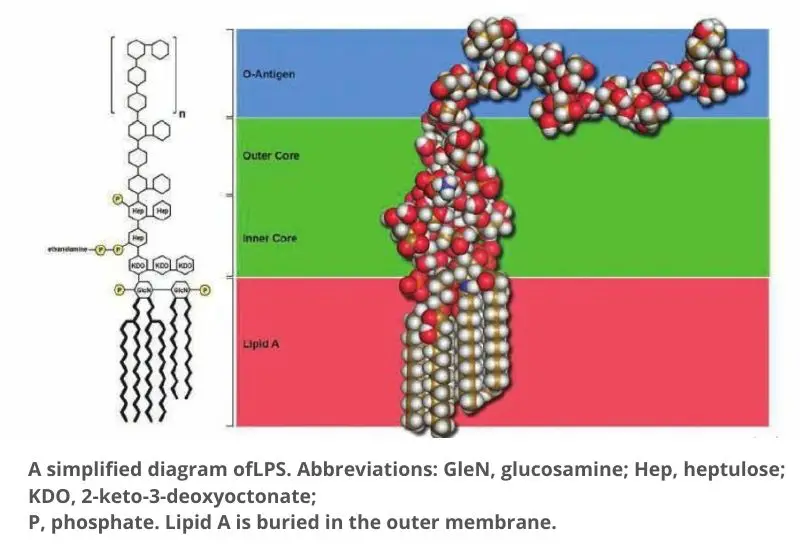
- The outer membrane of gram-negative bacteria is covered by lipo-polysaccharide, which is made up of polysaccharides covalently linked to lipid-A.
Lipid-A
- It consists of glucosamine, phosphate, and fatty acids. The Beta 1,6 linkage linked to glucosamine is the carbohydrates component lipid-A.
- The hydroxyl (-OH) and amino groups (-NH2) of these disaccharides are substituted by phosphate, pyro-phospet and fatty acids.
- The fatty acids provide hydrophilic property to lipid-A.
- There are 6 fatty acids – palmitic acid, lauric acid, myristic acid (Ratio 1:1:1), and 3 molecules of 3-hydroxy myristics acid.
Polysaccharide
- The polysaccharide portion of LPS of Salmonella cell wall consists of three important components such as inner core, outer core, and ‘O’-antigenic side chain.
- The ‘0’-antigenic side chain is absent in rough bacteria.
- The inner-core consists of two regions, the ket-deoxy-octane region (KDO) and Di Hepto region.
- The outer core consists of two molecules of GLC sandwiching a molecular galactose.
- The ‘O’-antigenic side-chain consists of four sugar Galactose, Rhamnose, mannose, and abequose.
- The O -antigenic side chain may be repeated many times according to species.
Functions
- It is responsible for the negative charge on the bacterial surface due to the presence of charged sugars and phosphate in core polysaccharide.
- It assists to maintain the outer membrane structure because lipid A is a primary component of the outer leaflet of the outer membrane.
- It assists to produce a permeability barrier. The geometry of LPS and communications between adjacent LPS units are thought to prevent the entrance of bile salts, antibiotics, and other toxic substances that might eliminate or injure the bacterium.
- It also protects the pathogenic bacteria front the host defense system. The O side chain of LPS is additionally termed as the O antigen because it evokes an immune response by an infected host. This response includes the formation of antibodies that adhere to the strain-specific form of LPS that evoked the response.
- The lipid A part of LPS can function as a toxin and is known as endotoxin. If LPS or lipid A invades the bloodstream, a pattern of septic shock produces for which there is no primary treatment.
Despite the part of LPS in forming a permeability barrier, the outer membrane is more porous than the plasma membrane and allows the entrance of small particles such as glucose and other monosaccharides. This happens due to the appearance of porin proteins.
External Component of Bacterial Cell Wall
Capsules
Some bacterial cells are surrounded by extracellular polymeric substances, forming a covering layer or envelope around the cell wall known as a capsule.
When this layer is well organized and not easily washed off, then it is called a capsule. When this layer is unorganized and washed off easily, then it is called a slime layer. Follow my previous article for study about composition, functions of capsules.
Flagella
Flagella are hair-like, helical, long surface appendages emerging from the cell wall. It is 20-30 nm in diameter and about 15um long. Read my previous article for detailed study of flagella types, definitions, structure, functions, etc.
Fimbriae and Pili
Some bacteria have short, fine, hair-like appendages that are not involved in motility, called fimbriae. Fimbriae differ from flagella in being shorter and thinner, straight and less rigid, but are in large numbers.
Sometimes fimbriae are referred to as pili. These pili are 0.2-20 um long with a diameter of about 250 Å. Read more about Fimbriae and Pili from my previous article.
Sheath
Some species of bacteria mainly aquatic chain forms and trichomes are enclosed by a hollow tube called sheaths.
Composition: Sheath is formed by several poly-saccharides.
Functions: It protects the bacteria from engulfment.
Surface layer
- Bacterial cell surfaces have a regularly two diameter array of protein, called S-layer.
- It also p[resent in archaebacteria, where it is the only wall structure outside the cytoplasm membrane.
Composition
- S-layers have a crystalline appearance and so various symmetries like hexagonal, tetragonal. It also has a pattern like floor tiles. It is composed of protein or glycoprotein.
Function
- Protect the cells against ion and pH fluctuation.
- It’s function is to behave as an external permeable barrier.
- It helps to maintain the shapes of the cells.
Prosthecae and stalk
- Prosthecae are semi-rigid extensions of the wall and cytoplasmic membrane.
- Stalk is sometimes used interchangeably with the prosthecae.
- It is tube-like appendages excreted by the cell of genera Planctomyces or gallionella.
Composition: Prosthecae are made by cell wall materials.
Functions:
- They increase surface area for nutrient absorption.
- Stalk helps in attachment.
Outer Membrane
- The outer membrane is an additional membrane of gram-negative.
- This layer is made of lipid bilayer, protein and lipopolysaccharide (LPS) layer.
- It lies outside the thin peptidoglycan layer.
- Outer Membrane is connected to the cell by Braun’s lipoprotein, the common abundant protein in the outer membrane
Function
- In gram-negative cells, the outer membrane functions as a structural component.
- In gram-negative bacteria LPS functions as an endotoxin.
- Lipid-A is antigenic.
FAQ
What is the function of the bacterial cell wall?
The bacterial cell wall provides structural support to the cell and protects it from osmotic lysis. It also helps maintain the shape of the cell.
What is the composition of the bacterial cell wall?
The bacterial cell wall is primarily composed of peptidoglycan, which is a polymer consisting of alternating units of two sugars and short peptide chains.
How do gram-positive and gram-negative bacteria differ in terms of their cell wall structure?
Gram-positive bacteria have a thick cell wall consisting of multiple layers of peptidoglycan, while gram-negative bacteria have a thinner cell wall consisting of a single layer of peptidoglycan surrounded by an outer membrane.
What is the function of lipopolysaccharides in the outer membrane of gram-negative bacteria?
Lipopolysaccharides are important in the immune response and can cause toxic effects in some animals.
How do antibiotics target the bacterial cell wall?
Many antibiotics work by inhibiting the synthesis or function of peptidoglycan, which makes the cell wall weaker and more susceptible to lysis, ultimately leading to bacterial death.
Can bacteria survive without a cell wall?
Some bacteria, such as Mycoplasma, are able to survive without a cell wall, but they have a specialized cell membrane that provides them with structural support.
How do bacteria build and maintain their cell walls?
Bacteria use enzymes to synthesize and modify peptidoglycan, and they use energy from ATP to transport peptidoglycan precursors across the cell membrane and incorporate them into the cell wall.
Are there any human diseases caused by defects in the bacterial cell wall?
Yes, defects in the bacterial cell wall can lead to diseases such as tuberculosis and leprosy.
How do bacteria evolve resistance to antibiotics that target the cell wall?
Bacteria can evolve resistance to antibiotics that target the cell wall by modifying the enzymes that synthesize peptidoglycan or by developing mechanisms to pump out the antibiotic.
Can the bacterial cell wall be used as a target for new antibiotics?
Yes, the bacterial cell wall can be used as a target for new antibiotics. The cell wall is a unique structure found in bacteria that is essential for their survival and plays an important role in maintaining the structural integrity of the cell.
Many antibiotics target the cell wall by disrupting its synthesis or by damaging its structure, leading to the death of the bacterial cell. For example, penicillin and other beta-lactam antibiotics target the cell wall by inhibiting the enzymes responsible for the synthesis of the peptidoglycan layer, which is a major component of the cell wall in many bacterial species.
Other antibiotics, such as vancomycin and teicoplanin, target the cell wall by binding to and disrupting the structure of the peptidoglycan layer itself. These antibiotics are particularly effective against gram-positive bacteria, which have a thick peptidoglycan layer in their cell walls.
In recent years, there has been a growing interest in developing new antibiotics that target the bacterial cell wall, particularly as resistance to existing antibiotics continues to increase. Researchers are exploring various approaches, including the development of new beta-lactams, as well as non-beta-lactam compounds that target the cell wall.
References
- http://www.textbookofbacteriology.net/structure_5.html
- https://www.onlinebiologynotes.com/bacterial-cell-wall-structure-composition-types/
- https://en.wikipedia.org/wiki/Bacterial_cell_structure#Cell_wall
- https://www.microscopemaster.com/cell-wall.html
- https://byjus.com/biology/cell-wall/
- https://en.wikipedia.org/wiki/Cell_wall
